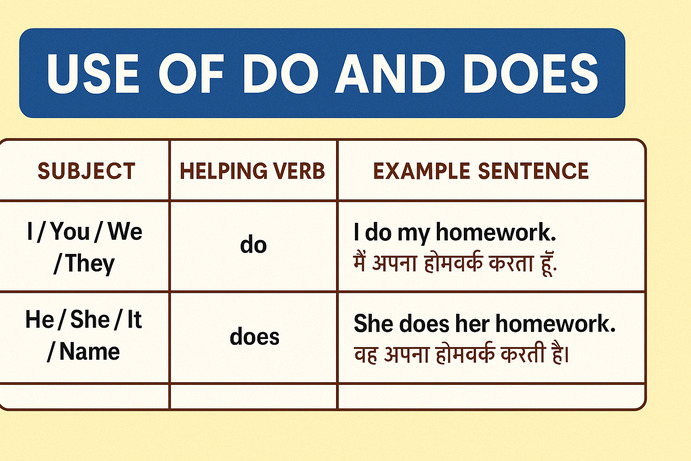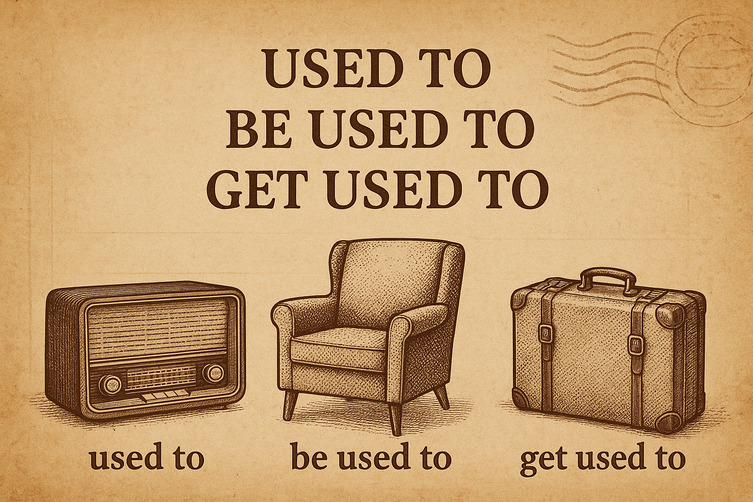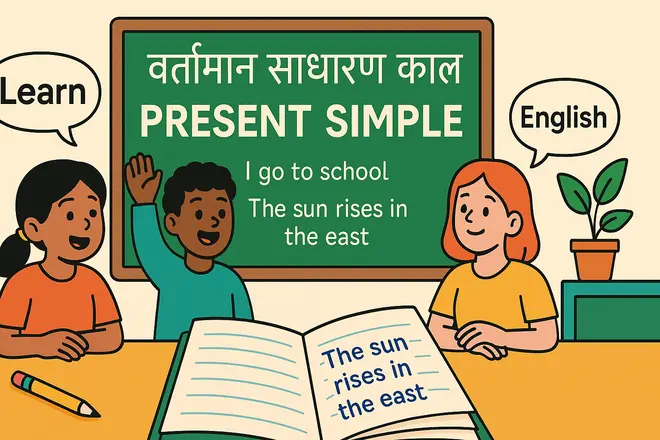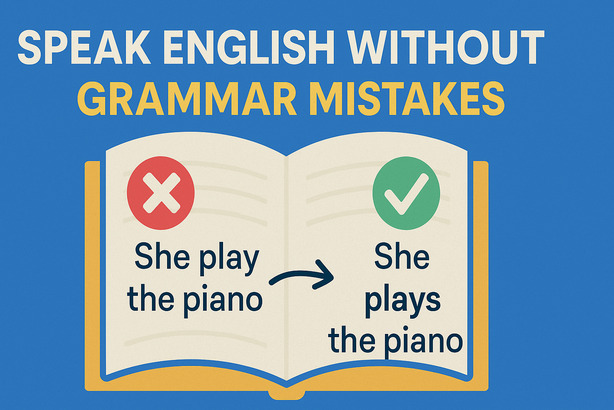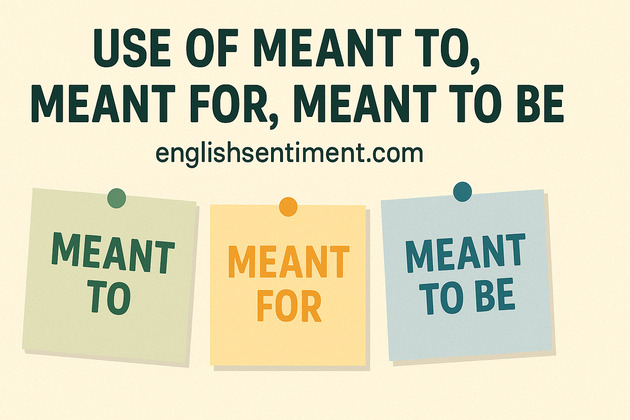Use of Do and Does: A Complete Guide for English Learners
Meta Description:
Master the use of “do” and “does” in English grammar with this detailed guide. Learn grammar rules, examples, exercises, and common mistakes. Ideal for beginners to advanced learners. Includes Hindi and Roman Urdu translations.
Introduction: Why Learning the Use of Do and Does Is Important
In English grammar (अंग्रेज़ी व्याकरण – angrezi vyaakaran), the use of “do” and “does” plays a crucial role in forming questions, negative sentences, and adding emphasis in the present tense. These two auxiliary verbs (सहायक क्रिया – sahayak kriya) are small but mighty. Understanding when and how to use them correctly can drastically improve your speaking and writing skills. Whether you are a beginner learning basic grammar rules or an advanced learner looking to refine your usage, this article will guide you through everything you need to know.
1. Basic Level: Use of Do and Does for Beginners
What Are “Do” and “Does”?
“Do” and “does” are auxiliary (helping) verbs used primarily in the simple present tense. They help us form questions and negative sentences. They can also be used for emphasis.
Subject-Verb Agreement Table
| Subject | Helping Verb | Example Sentence | Hindi Translation |
|---|---|---|---|
| I / You / We / They | do | I do my homework. | मैं अपना होमवर्क करता हूँ। (main apna homework karta hoon.) |
| He / She / It / Name | does | She does her homework. | वह अपना होमवर्क करती है। (woh apna homework karti hai.) |
Positive Sentences
In simple affirmative (सकारात्मक – sakaratmak) sentences, we do not use “do” or “does” as helping verbs.
Examples:
- I go to school every day. (मैं हर दिन स्कूल जाता हूँ। – main har din school jata hoon.)
- She works in a hospital. (वह एक अस्पताल में काम करती है। – woh ek aspataal mein kaam karti hai.)
Negative Sentences
Use “do not” or “does not” to form negative sentences in the present tense.
Rules:
- Use do not (don’t) with: I, you, we, they
- Use does not (doesn’t) with: he, she, it
Examples:
- I do not like tea. (मुझे चाय पसंद नहीं है। – mujhe chai pasand nahin hai.)
- He does not play cricket. (वह क्रिकेट नहीं खेलता। – woh cricket nahin khelta.)
Question Sentences
To form questions, place “do” or “does” at the beginning of the sentence.
Examples:
- Do you speak English? (क्या आप अंग्रेज़ी बोलते हैं? – kya aap angrezi bolte hain?)
- Does she live in Delhi? (क्या वह दिल्ली में रहती है? – kya woh dilli mein rehti hai?)
2. Intermediate Level: Deeper Understanding of Do and Does
Emphatic Sentences
We use “do” or “does” in affirmative sentences to show emphasis (ज़ोर देना – zor dena).
Examples:
- I do want to help you! (मैं सच में आपकी मदद करना चाहता हूँ! – main sach mein aapki madad karna chahta hoon.)
- He does love his job! (वह सच में अपने काम से प्यार करता है! – woh sach mein apne kaam se pyaar karta hai!)
Short Answers
When replying to questions briefly, we often use “do” or “does” alone.
Examples:
- Do you play football? – Yes, I do.
- Does she cook well? – No, she doesn’t.
Tag Questions
Tag questions (confirmation questions at the end of a sentence) use “do” or “does.”
Examples:
- You like coffee, don’t you? (आपको कॉफी पसंद है, है ना? – aapko coffee pasand hai, hai na?)
- He studies hard, doesn’t he? (वह कड़ी मेहनत करता है, है ना? – woh kadi mehnat karta hai, hai na?)
Practice Table: Do vs. Does
| Sentence Type | Subject | Helping Verb | Example |
| Question | You | do | Do you like movies? |
| Negative | She | does not | She does not drive a car. |
| Emphatic | I | do | I do enjoy painting. |
| Short Answer | He | does | Does he run? Yes, he does. |
3. Advanced Usage of Do and Does in English
In Imperative Sentences
Sometimes, “do” is used to make polite or emphatic requests.
Examples:
- Do have a seat. (कृपया बैठ जाइए। – kripya baith jaiye.)
- Do call me if you need anything. (ज़रूरत हो तो मुझे जरूर कॉल करें। – zarurat ho to mujhe zarur call karein.)
In Subordinate Clauses
“Do” or “does” can appear in subordinate (dependent) clauses to express doubt, emotion, or indirect questions.
Examples:
- I wonder if he does know the answer. (मुझे आश्चर्य है कि क्या वह जवाब जानता है। – mujhe aascharya hai ki kya woh jawab jaanta hai.)
- It doesn’t matter whether you do agree or not. (इससे फर्क नहीं पड़ता कि आप सहमत हैं या नहीं। – isse farq nahin padta ki aap sahmat hain ya nahin.)
Formal and Literary Usage
In formal or literary English, “do” and “does” are sometimes used stylistically for rhythm or formality.
Example:
- Never does he speak a lie. (वह कभी झूठ नहीं बोलता। – woh kabhi jhooth nahin bolta.)
4. Do and Does Examples and Exercises
Fill in the Blanks
- _____ she like to dance?
- They _____ not come here often.
- I _____ enjoy reading.
- _____ you know the way?
Answers:
- Does
- do
- do
- Do
Sentence Correction
- He don’t like mangoes. ❌
- Do she know him? ❌
Corrected:
- He doesn’t like mangoes. ✅
- Does she know him? ✅
Make Your Own Sentences:
- Use “do” in a question.
- Use “does” in a negative sentence.
- Use “do” to emphasize an action.
5. Common Mistakes in the Use of Do and Does
| Mistake | Correct Sentence | Hindi Explanation |
| She do not go to school. | She does not go to school. | “She” के साथ “does” का प्रयोग होता है। |
| He don’t likes music. | He doesn’t like music. | “Like” को base form में ही रखना चाहिए। |
| Does I need a ticket? | Do I need a ticket? | “I” के साथ “do” प्रयोग होता है, “does” नहीं। |
6. Tips to Master the Use of Do and Does
- ✅ Learn the Subject-Verb Table: Memorize which subjects go with “do” or “does.”
- ✅ Practice Daily: Use practice apps or journals to write five sentences daily using “do” and “does.”
- ✅ Watch English TV Shows: Observe how native speakers use these verbs in conversation.
- ✅ Read Aloud: Reading aloud helps reinforce grammar structure.
- ✅ Use Flashcards: Create flashcards with subject-verb combinations for regular review.
7. Conclusion: Master the Use of Do and Does
The use of do and does is foundational to English grammar. From forming basic questions to expressing emotions with emphasis, these verbs appear across all levels of English communication. Through structured learning, daily practice, and awareness of common mistakes, you can master their use. Whether you’re a beginner just starting or an advanced learner polishing your skills, this topic is vital to fluency.
For more lessons like this, visit English Sentiment, your go-to resource for learning English with Hindi and Roman Urdu support.

